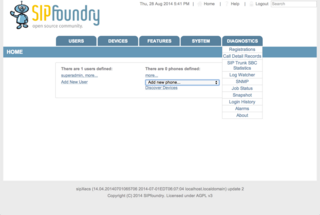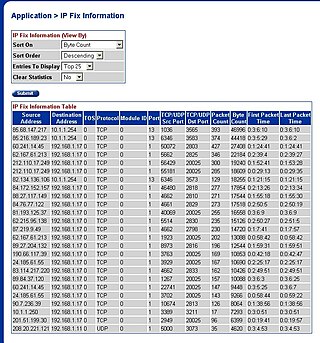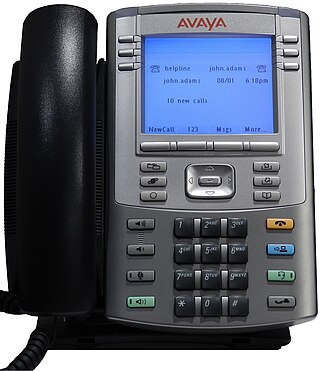
Avaya LLC, often shortened to Avaya, is an American multinational technology company headquartered in Morristown, New Jersey, that provides cloud communications and workstream collaboration services. The company's platform includes unified communications and contact center services. In 2019, the company provided services to 220,000 customer locations in 190 countries.

SipXecs is a free software enterprise communications system. It was initially developed by Pingtel Corporation in 2003 as a voice over IP telephony server located in Boston, MA. The server was later extended with additional collaboration capabilities as part of the SIPfoundry project. Since its extension, sipXecs now acts as a software implementation of the Session Initiation Protocol (SIP), making it a full IP-based communications system.

Nortel Meridian is a private branch exchange telephone switching system. It provides advanced voice features, data connectivity, LAN communications, computer telephony integration (CTI), and information services for communication applications ranging from 60 to 80,000 lines.

Multi-link trunking (MLT) is a link aggregation technology developed at Nortel in 1999. It allows grouping several physical Ethernet links into one logical Ethernet link to provide fault-tolerance and high-speed links between routers, switches, and servers.
Unified communications (UC) is a business and marketing concept describing the integration of enterprise communication services such as instant messaging (chat), presence information, voice, mobility features, audio, web & video conferencing, fixed-mobile convergence (FMC), desktop sharing, data sharing, call control and speech recognition with non-real-time communication services such as unified messaging. UC is not necessarily a single product, but a set of products that provides a consistent unified user interface and user experience across multiple devices and media types.

The Ethernet Routing Switch 5500 Series or is a series of stackable, Layer 3 switches used in computer networking. The ERS 5000 was originally designed by Nortel and is now manufactured by Avaya. Up to 8 ERS 5000 Series Switches may be stacked in a 640 Gbit/s fast stacking configuration. This Switch was used as the access layer device for the 2010 Winter Olympics games. The 817 Access Switches supported 8782 Voice-over-IP telephones.
UNIStim is a deprecated Telecommunications protocol developed by Nortel for IP Phone and IP PBX communications.

Avaya IP Phone 1140E in telecommunications is a desktop Internet Protocol client from 1100-series manufactured by Avaya for unified communications. The phone can operate on the Session Initiation Protocol (SIP) or UNIStim protocols. The SIP firmware supports presence selection and notification along with secure instant messaging. This device has an integrated 10/100/1000BASE-T auto-sensing Ethernet switch with two ports and an integrated USB port, and is Bluetooth capable. The SIP version of this phone has full IPv6 functionality and only requires 2.9 watts of power.
The Avaya Secure Router 4134, in telecommunications and computer networking technologies, is a device manufactured by Avaya that combines the functions of WAN Routing, stateful firewall security, Ethernet switching, IP telephony, and Microsoft mediation into one device. In addition to sharing many features with other routers such as VRRP, MPLS, and hot-switchable modules, the SR-4134 also guards against individual circuit failures, has the ability to recover from device failures in less than a second, and instantly restores bandwidth once a connection has been repaired. The system is very energy-efficient and can save the owner as much as 40% on energy total cost of ownership, according to testing by the Tolly Group. In July 2011, it was integrated with the Silver Peak WAN optimization appliance to optimize the performance of enterprise voice, video, and unified communications (UC), to ensure that remote users have fast and reliable access to all centralized applications.
The Nortel Discovery Protocol (NDP) is a data link layer network protocol for discovery of Nortel networking devices and certain products from Avaya and Ciena. The device and topology information may be graphically displayed network management software.
NetExpert monitors and controls networks and service impacting resources using object-oriented and expert systems technologies.

Ethernet Routing Switch 5600 Series or in computer networking terms are stackable routers and switches designed and manufactured by Avaya. The ERS 5600 Switches can be stacked up to 8 units high to create a 1.152 Tbit/s backplane through the Flexible Advanced Stacking Technology (FAST) stacking technology configuration. The 5600 Series consists of five stackable models that can be mixed and matched together with other ERS 5600 models or other ERS 5500 models to meet configuration requirements. Additionally the ports on the switches incorporates the Avaya Energy Saver (AES) which can manage and dim down the power requirements to save energy across all switches in the enterprise.
OpenKBM is a set of computer software for systems management of applications that use knowledge management techniques.
HP Network Management Center (NMC) is a suite of integrated HP software used by network managers in information technology departments. The suite allows network operators to see, catalog and monitor the routers, switches, and other devices on their network. It alerts IT staff when a network device fails and predicts when a network node or connection point may go down. The suite was designed to address operational efficiency.

Avaya 9600-series IP deskphones are 15 different desk handset devices that are used for unified communications. The phones are compatible with the Avaya Aura platform of products and IP office systems. The systems add high-quality voice codecs like the G.722 codec and new menus over older IP phone series. The 9620 includes 16 MB of flash memory and the 9630 includes 32 MB of flash memory.
The 1100-series IP phones are 6 different desktop IP clients manufactured by Avaya for Unified communications which can operate on the SIP or UNIStim protocols. The SIP Firmware supports presence selection and notification along with secure instant messaging.
A number of tools exist to generate computer network diagrams. Broadly, there are four types of tools that help create network maps and diagrams:
Fabric Connect, in computer networking usage, is the name used by Extreme Networks to market an extended implementation of the IEEE 802.1aq and IEEE 802.1ah-2008 standards.

Ethernet Routing Switch 3500 series and Ethernet Routing Switch 2500 series or ERS 3500 and ERS 2500 in data computer networking terms are stackable routing switches designed and manufactured by Avaya.









